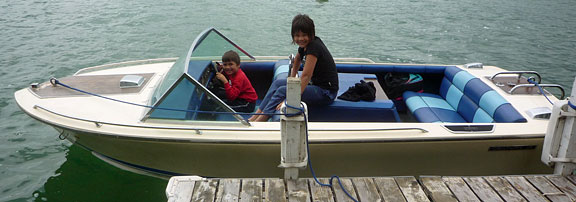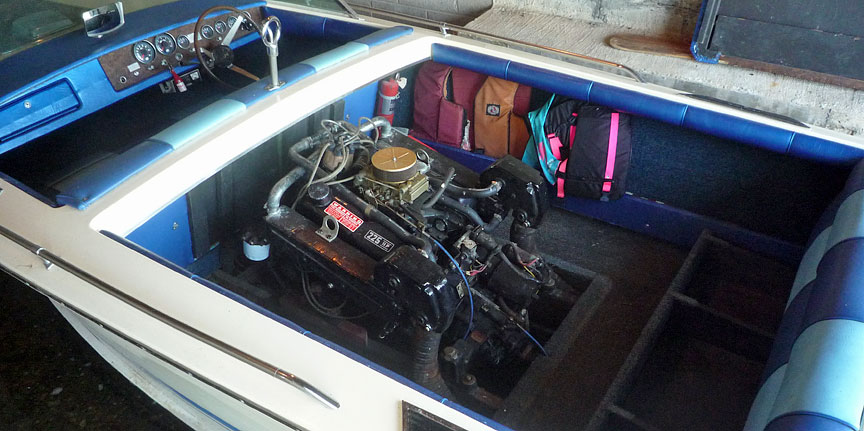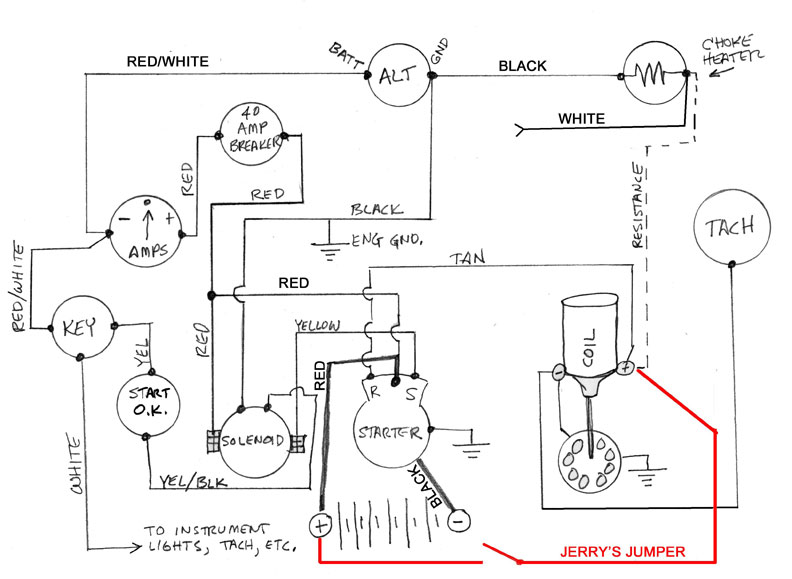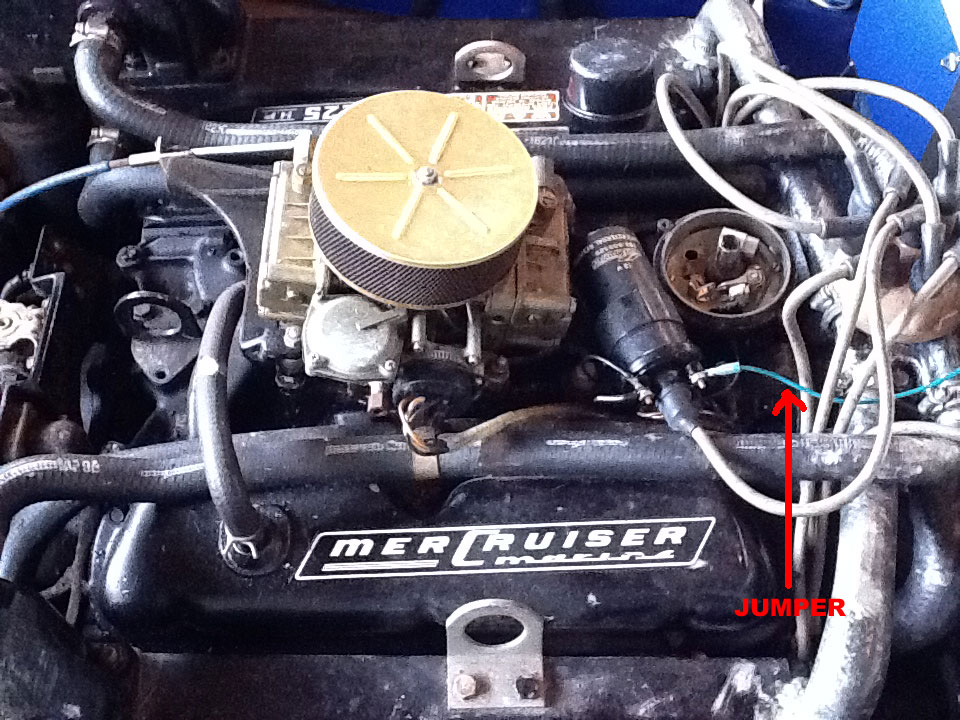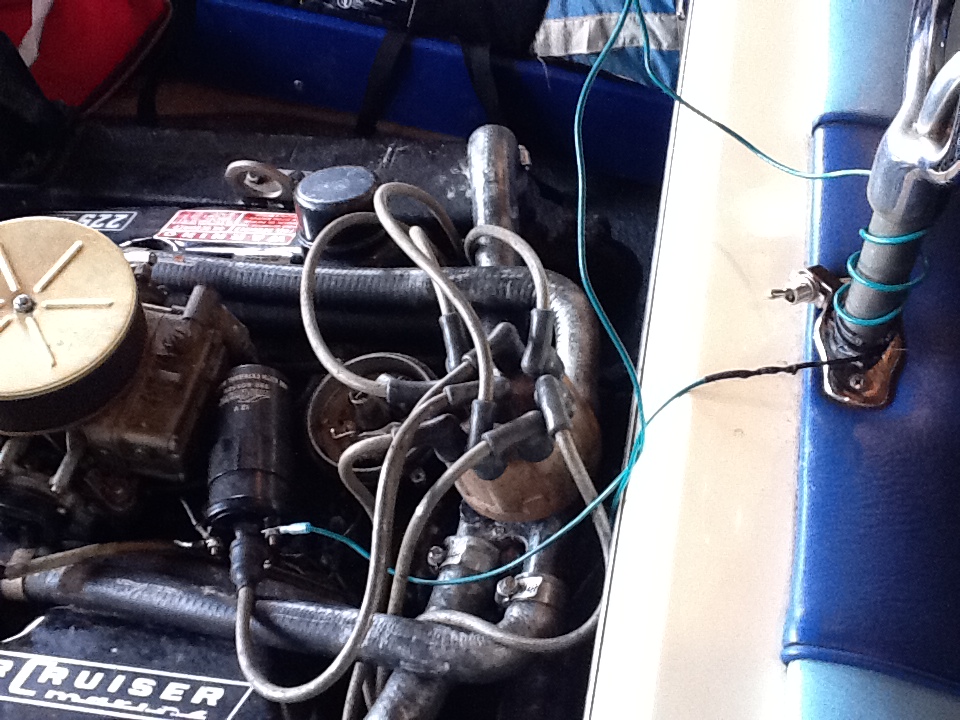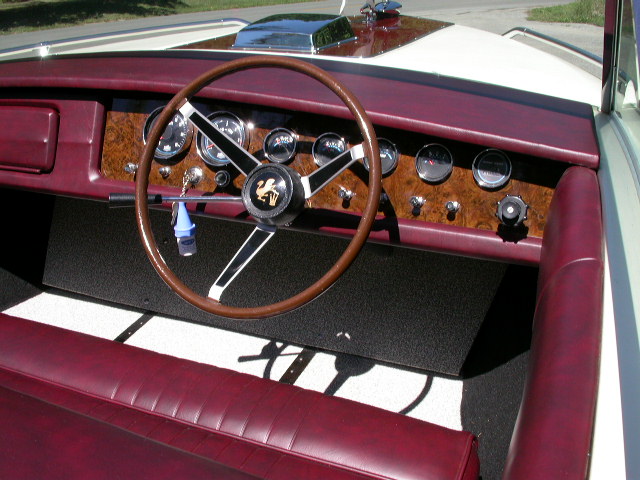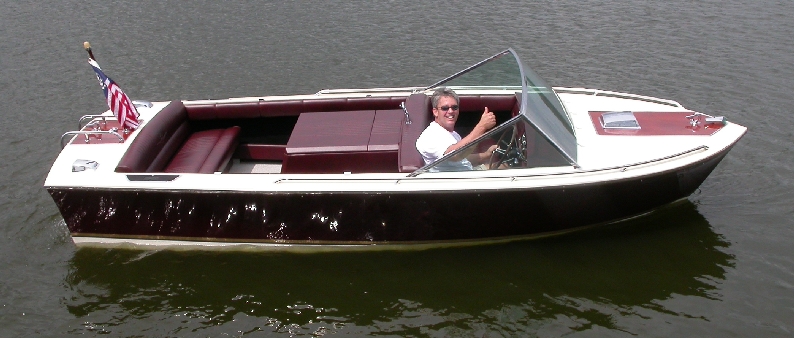("Click" for larger images, but you knew that.) In the fall of 2010, Jerry P. winterized the Century Resorter, scrubbed its hull with acid, put it on its bunks in its boat house, installed a new battery and covered it with an older cover donated by Chuck P. In 2011, after wintering in LL16 boat house, bunks were removed, the boat was lowered into the water by Grant and Jerry P., and it started easily for Jerry. Everything seemed to "check out OK." We just let it run, get to temperature and then shut it down. With other things to do, we did not even take it out of the boathouse. Earlier in 2011, I had cleaned out three fuel cans and used them to top off the boat's 30 gallon tank.



A day or two after running it to temperature, I tried starting the boat. I had had the charger hooked up for 24 hours beforehand. It showed the battery was fully charged. The starter cranked the engine strongly, but it would not fire. I phoned Jerry, who said he had done nothing special, other than "pumping" the throttle control when he started it a couple days earlier. (I noticed the Holley carb does have an accelerator pump. With the flame arrestor off, I saw fuel squirt while "pumping" the control.) The number on the hull is ceb4a0500673

Jerry suggested using a jumper wire he had made for his classic boats "to bypass high resistance in the older ignition switches." So I used Jerry's bypass cable ("Jerry's Jumper" on simple schematic) on the Century, and it fired right up! Later that day, the boat started without the cable, but died and would not restart when I had it out on the lake, manoeuvering to a mooring in windy conditions. I was blown to a nearby pier, steering with a paddle in 20 mph winds. I could not paddle (other than steer) the Resorter; it's a much heavier boat than my Four Winns. Jerry delivered the cable to me again. I started the boat, drove it back to LL16's pier, and put it back in the boat house. I returned to St. Louis, made a cable like Jerry's, and ordered a new ignition switch (211896) from West Marine. (The 485799 version has a rubber boot over the key slot.) The new switch would replace one that is about 40 years old, but looking at the schematic, I suspected the switch may not be the problem.

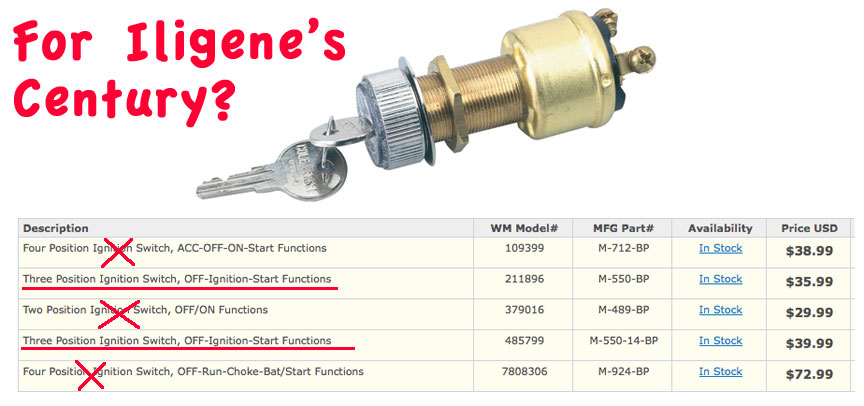



Others agreed; the problem might be other than high resistance in the ignition switch. Larry L says engines of the mid-1970's era (this is "70's" Ford 302 V-8, a MerCruiser conversion by Mercury Marine) use a resistor in the line feeding power (possibly 7 volts) to the coil for running the engine, and a "full 12 volts" during start. (See my Simplified Schematic.) (I drew the Simplified Schematic, using the much more complete drawing in the Mercury Owner's manual as my information source.) My schematic shows a number of things about the electrical system of which I was unaware. There are TWO solenoids, one activated by the key switch and one on the starter.
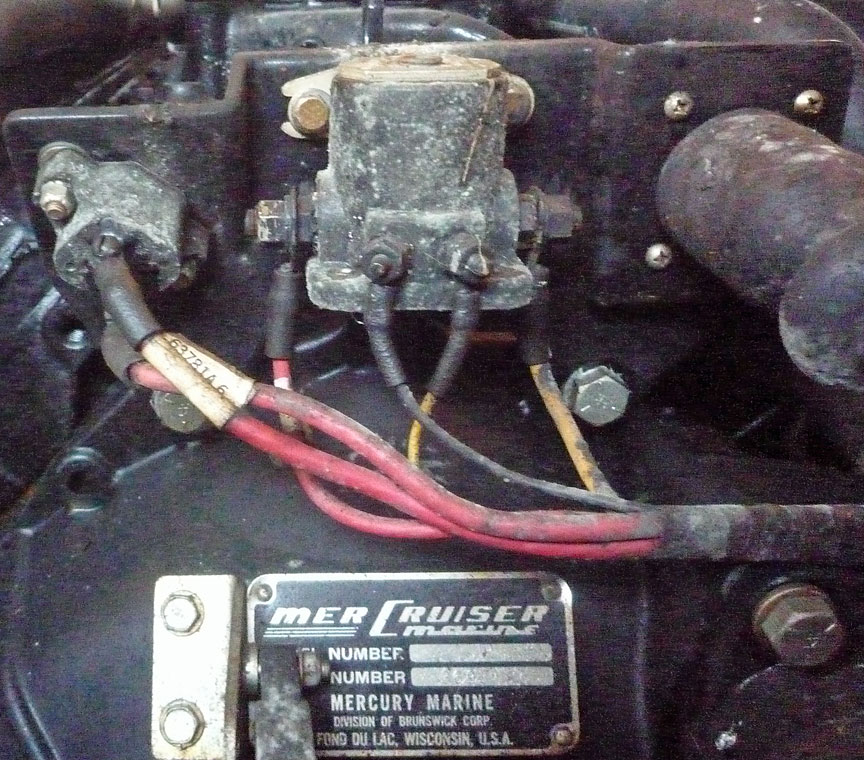 XXX
XXX
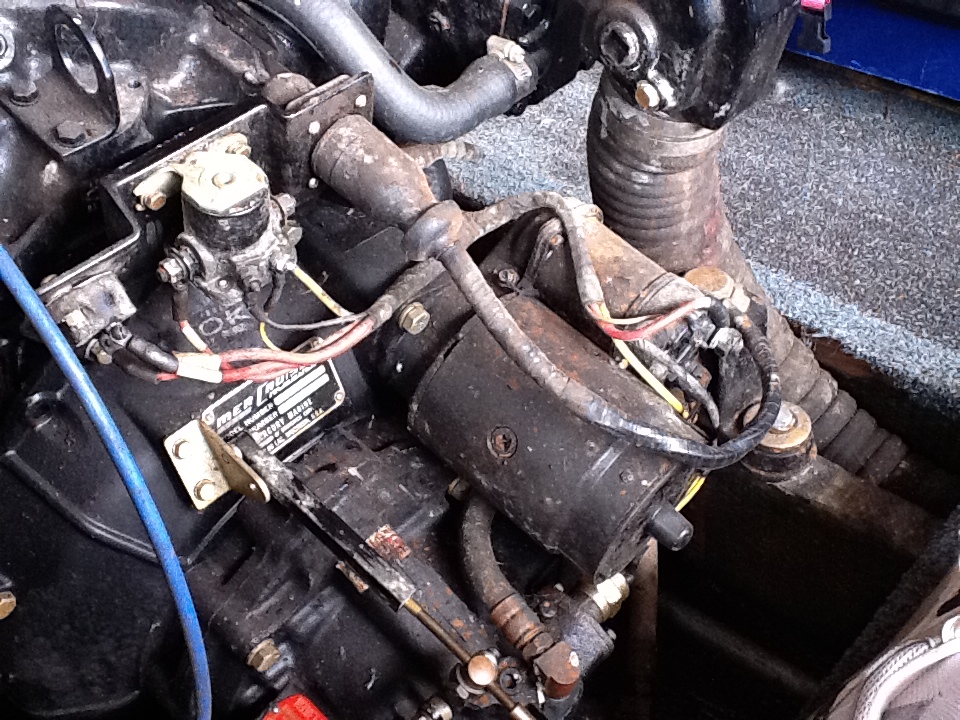
Above photo on the right shows the 40 amp breaker on the left, My hunch now is that the solenoid on the starter has a poor contact (at "R" -- which is confusing me. Shouldn't "R" = "run?") that should be feeding full "12 volts" during "Starting" via the tan wire to the + terminal on the coil. Look again. Later, on 6/19/11, I found that NAPA's part SD 503 (at $16.49) is a replacemnt for the boat's starter solenoid. A new starter solenoid might eliminate the need for the Jumper wire. One expert "old engine guy" told me he frequently finds that tightening all the electrical connections can solve many problems. I'll do that, esp. on the terminals shown in my drawing. (DONE.) Another suggested I use my digital VOM and check the voltage at the coil, but I can find no specs. describing the "designed" voltage. I was thinking maybe 7 volts for running, 12 to 14 for starting. If the jumper works, I do not intend to "run" the engine with the jumper cable in place and switched "on," but wonder if I forget to switch it "off," will the coil be damaged? I've done a lot of web-searching for "electric choke heater," but can't find anything similar to my situation with this boat engine -- i.e, what "turns it on?" It seems this kind of heater is used in "cool" environments where engine heat is scarce (like using lake water for cooling?) I got interested in the heater because the "starting voltage" to the coil is fed by a wire that first runs to the heater, on its way to the the + terminal on the coil during starting. BTW, the heater gets hot and stays hot when the ignition swith is "on."

Back in St. Louis, I was looking forward to getting back to Wisconsin and running the Century. (I had not been skiing yet this year, and 225 HP pops you right up.) Later -- in June, 2011, I did get to ski behind this boat, but was using skis and VERY SHORT tow rope, all belonging to others; it was not that much fun. I mentioned the new battery installed in the Fall of 2010. Now notice the positive connection is only a "trolling motor" tab. At one point when trying to get the boat started, the connection got VERY HOT -- enough to burn one's skin. The cable, or at least its battery connector, should be replaced. I'll work on this later. John S. has a "crimper" I can use. 
As an aside, IMHO now, this boat is way overpowered. (225 hp in a 16 ft. boat.) Some notes:
6/13/11 -- Did not try to start, but measured battery voltage and voltage at + terminal on coil.
6/18/11 -- Installed new ignition switch and my version of Jerry's Jumper: 
Measured: at coil, with switch "off" = 4.92 volts at coil, with switch "on" = 12.0 volts Grant and Mazzaya cleaned plugs, using emery paper. Engine now idled OK, but had no power. Would not plane and did not run smoothly. The plugs showed poor combustion: 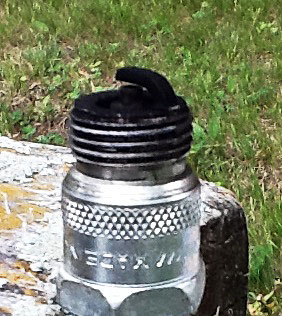

Grant removed Heathkit Fume Detector "box" located under dashboard, and most associated wiring. He thinks it had not functioned for years. 
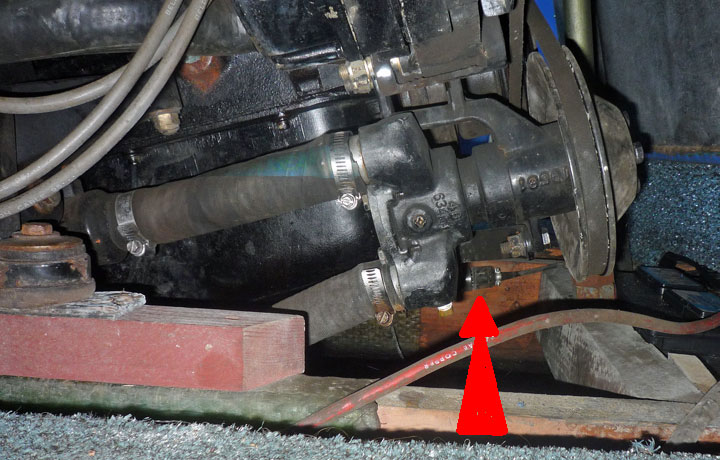
6/19/11 -- Installed (replaced) a NAPA 3225 water separator. Found a tiny bit of debris in the bottom of the old one; certainly not enough to cause problems, but I did not know when it was last changed. I do wonder what that sediment bowl is doing there, close to the filter/separator. Maybe the filter replaces the function of the bowl?
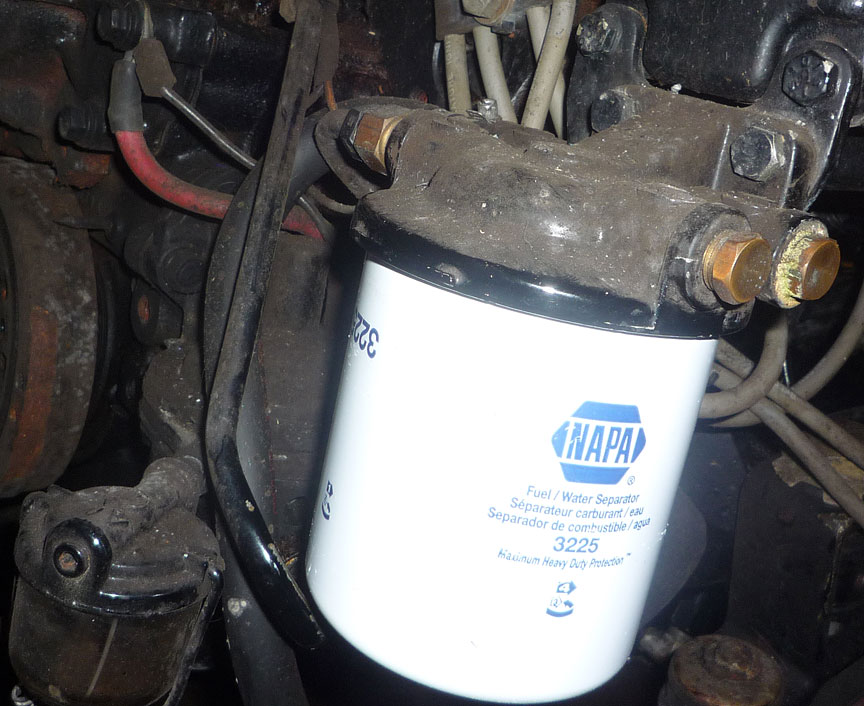
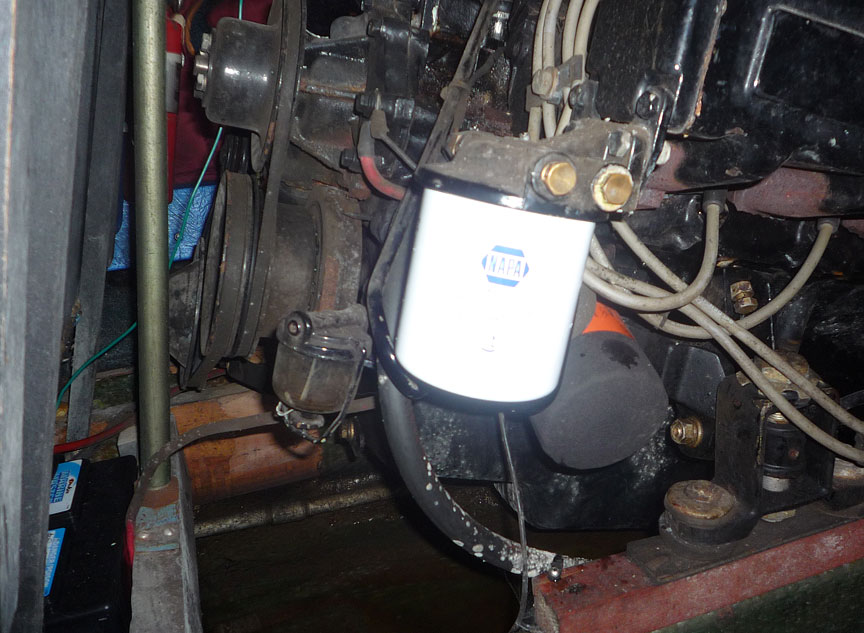
Cleaned and replaced plugs at Jerry's: 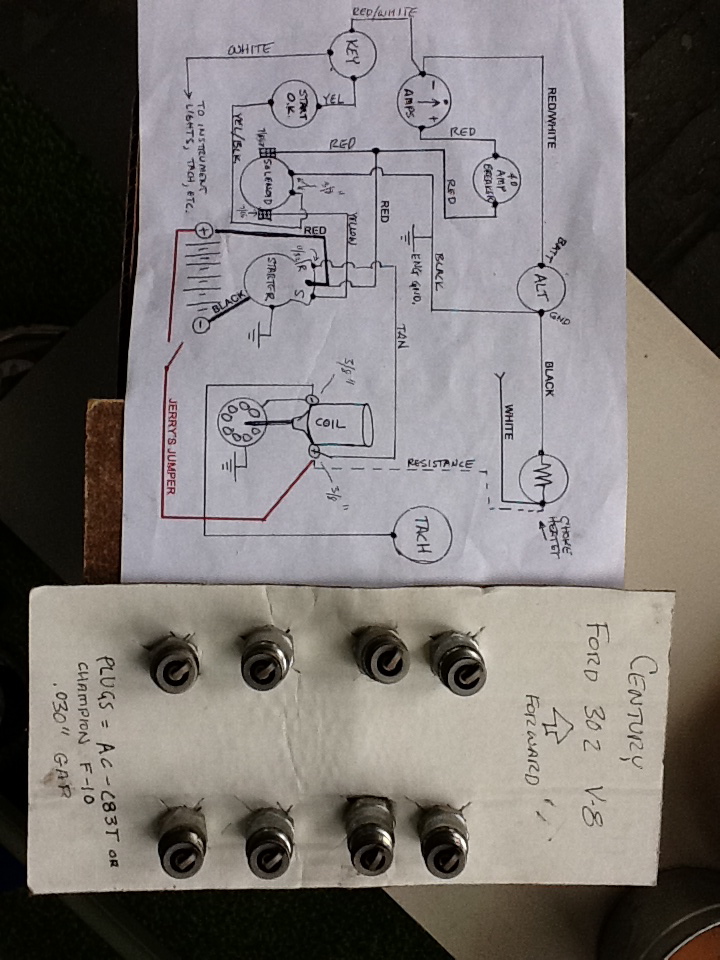
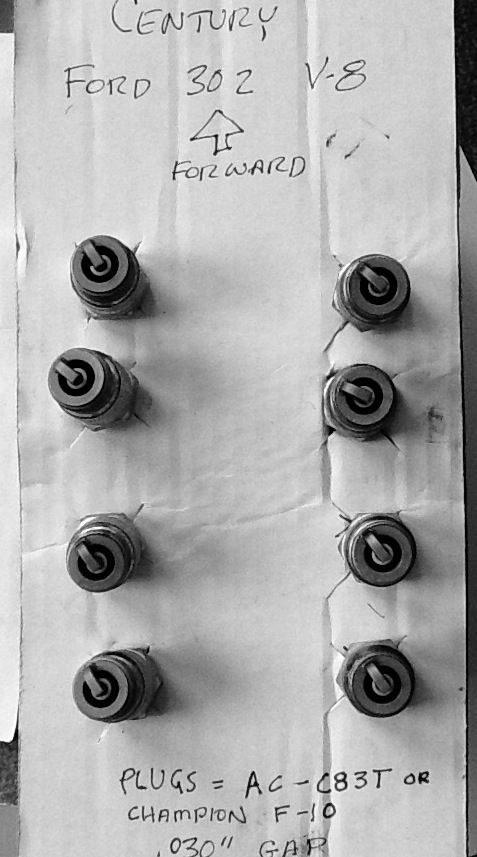
THE (CURRENT) PROBLEM(S) IDENTIFIED The jumper is providing "starting current" to the coil, jumping a (suspected) high-resistance contact in the starter solenoid. The condenser had failed and has been replaced by Grant. Grant dressed breaker points set gap to .017".
Grant cleaned plugs (at Jerry's) and replaced them. On the left, a photo of a plug after being cleaned by Mazzaya and Grant, and the brief "no power" run on 6/18. On the right, after the successful skiing run and tour of the lake: 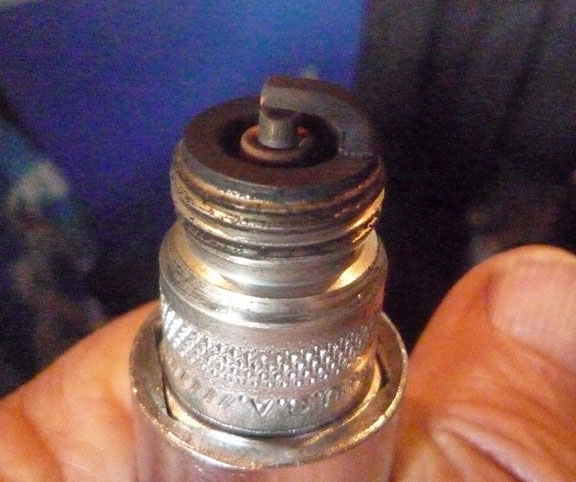
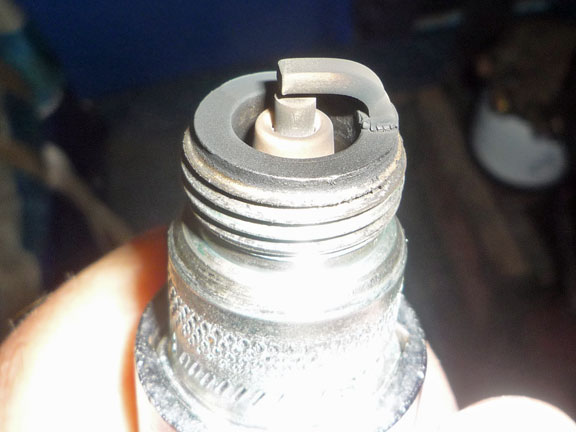
It would have been better to replace the points, but without a timing light, etc., Grant did not want to try.
About a "condenser" (more properly a "capacitor."): In a message dated 6/28/2011 9:45:41 P.M. CDT, Grant MacLaren wrote to Mark Schenberg:
Mark,

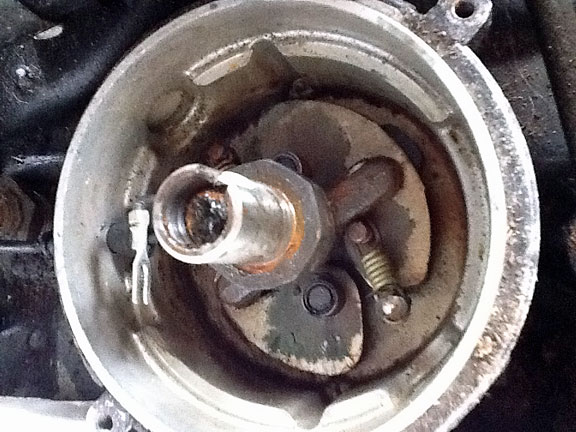
The "jumper" cable worked, but I got it so the jumper was not needed
to start it. I filed the points and set the gap. But I think the real problem
was a bad condenser. A friend (larry L,) with an "old car book" looked up the
symptoms (starts good, idles and runs smoothly, but has no power when
throttle opens) and read me, over the phone, a few options. One option
was a bad condenser. I had to buy a set of points to get the condenser, but
was afraid to install the points because I could not find the timing marks,
and had no timing light. I found I could "jog" the starter and get the
distributor to turn the last few degrees (to set the gap) using the spring
play in the advance.
Mark replied: Mark also told me that the "harmonic balancer" rubber might let its outer rim move a lot -- enough to really mess up the timing marks. In any case, I have not yet found the timing marks. I'll look during my next visit.
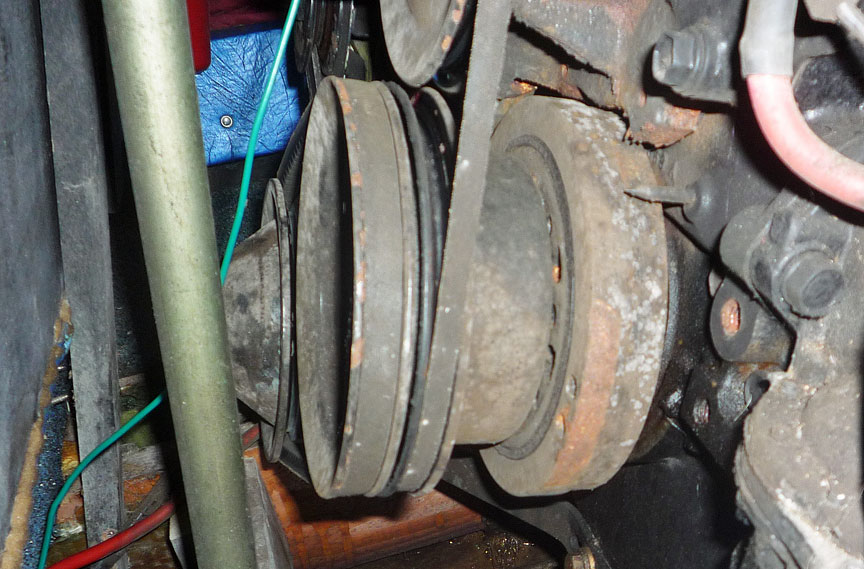
Hard Starting (found on Internet) A bad or missing resistor bypass line can do it. Put a test light on the + side and watch it during starts. If the light all but goes out, use a clip lead to connect straight to the battery for full coil power as a test. In order to increase the coil voltage at startup some ignition designs incorporate a "ballast" resistor. The resistor is switched in and out of the supply voltage to the coil. Once running, the resistor is switched in place and the coil is actually getting less than 12volts. When the engine is started, the resistor is removed and the coil gets the full 12volts. This provides a much better spark at startup to compensate for reduced battery voltage drawn by the starter. When starting a cold engine, the plugs and the air are cold, the cylinder pressure is up, and the fuel/air mixture is poorly controlled. The oil is thick, the battery is cold and its voltage drops as much as 60% because of the high current drained by the starter motor. A failing condenser will cause weak spark. If the distributor was removed, it may have been put in wrong. Yes, it can make a difference where it lands as it's reinstalled. If it's too far off, the coil will fire during correct timing with the rotor all but out of position. If it's a half inch away from the cap terminal, it will either not fire, not start easily, or rev up too much if it does start. If you can't seem to time it, pull it out and start over with TDC and then reset it in the hole. Bad spark plug wires are not too uncommon, but they don't all fail at once! They degrade over time, but not catastrophically and all 8 (or 6). Same for plugs. Measure the wires. They should be several thousand ohms depending on the type used. They should be within 10% of each other though. Buildup on the points will cause the timing to move off, and if it's bad enough, the points will fail to switch anymore.
TESTING AUTO CAPACITORS (found on Internet) I do a functional check on capacitors, or condensers if you like, using a simple analog volt meter; the old kind with a meter that has a needle. Basically, set the meter to the ohms setting and measure the resistance. For a good capacitor, the needle should jump towards zero then move towards infinity as you make contact with it. Then switch the meter leads and do it again. This time the needle should jump about twice as far. The first time you are putting a charge of 1.5 volts on the capacitor. When you reverse the leads, you are reversing the charge so the needle will jump further. One end of the capacitor must be disconnected from the circuit. If the meter has some selection, choose a high resistance range. If the needle stops at a resistance value other than infinity, it is leaking the charge and is bad. Ed Stoller
(These two photos are NOT the boat under discussion here; it is a recently restored, fine looking boat of the same make and model. But I think it's longer, maybe 18'.)
Here's a boat listed at ABC. Similar to Iligene's Century:





|

